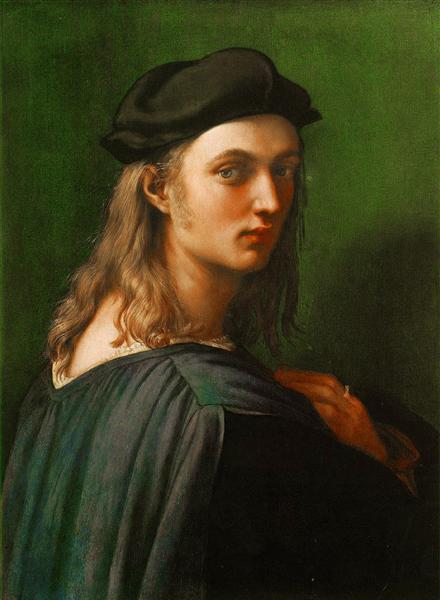Kuvaus
The "Portrait of Bindo Altoviti", painted by Raphael in 1515, stands as a notable example of Italian Renaissance artistry and reflects the artist's ability to combine the depiction of individuality with the aesthetic ideals of his time. This work focuses on Bindo Altoviti, a Florentine nobleman and patron of art, whose image is presented with an air of dignity and serenity.
The composition of the painting reveals Raphael’s predilection for portraiture as a form of personal expression. Altoviti appears in almost three-quarter focus, his face illuminated by a soft light that highlights his serene features and introspective gaze. The direction of his gaze—to the left—suggests a subtle dialogue with the viewer, creating a connection that transcends time. Raphael manages to capture not only the physical appearance of the sitter, but also an impression of his character, which exudes confidence and contemplation.
The use of colour in this work is particularly notable. Raphael employs a rich, nuanced palette, dominated by dark tones, reflecting the Renaissance fashion for noble dress. The blue tunic Altoviti wears not only complements his fair skin, but also symbolises the wealth and status of its wearer. Subtle touches of light on the fabric highlight the texture and volume, demonstrating Raphael's mastery in the representation of materials.
Behind Altoviti is a greyish background that helps to focus attention on the subject, as well as providing an atmosphere of depth. This neutral background, which is characteristic of many of Raphael's works, allows the figure to stand out, making the portrait an intimate and personal space. The way the light plays on Altoviti's face shows a clear influence of the humanist ideals of the time, in which human beauty and morality are intertwined.
An interesting aspect of the work is its history as a commission. Bindo Altoviti was a prominent figure in the Florentine artistic circle and had close relations with several Renaissance artists, as can be seen in his choice of Raphael for his portrait. This fact not only underlines Raphael's prestige as a portraitist, but also reflects the social dynamics of the time, where art and nobility were intimately intertwined.
Raphael, known for his ability to capture the essence of his subjects, stands out in this work for his ability to synthesize the ideal of Renaissance art: balance, harmony and a profound respect for humanity. "Portrait of Bindo Altoviti" fits into a long tradition of Renaissance portraits that seek not only to represent the individual, but also to celebrate human dignity.
In short, the “Portrait of Bindo Altoviti” is a work that not only highlights Raphael’s technical mastery, but also encapsulates the rich complexity of his time. Through this exploration of Altoviti’s personality, Raphael transcends mere visual representation, inviting the viewer into a deeper reflection on identity, status, and art in the Renaissance.
KUADROS ©, a famous painting on your wall.
Hand-made oil painting reproductions, with the quality of professional artists and the distinctive seal of KUADROS ©.
Painting reproduction service with satisfaction guarantee. If you are not completely satisfied with the replica of your painting, we will refund 100% of your money.

